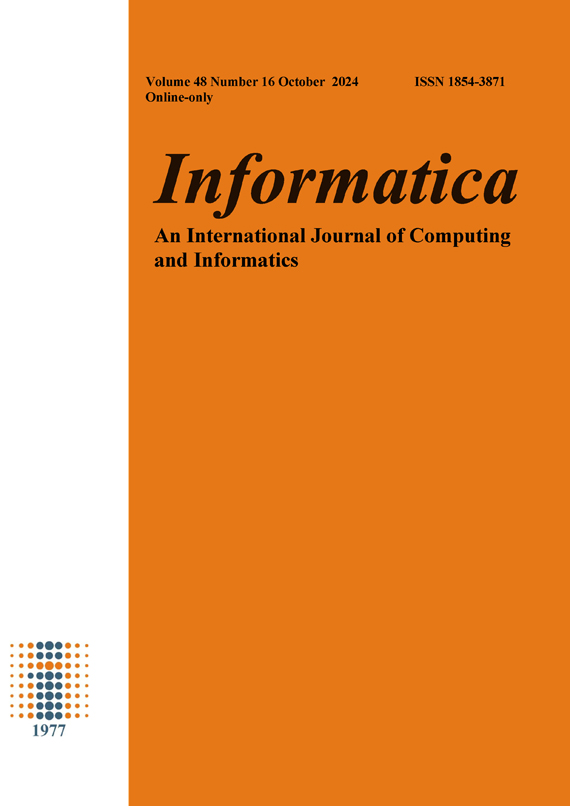Dynamic Patient Scheduling in Hospitals Using Variable Length Non-Dominated Sorting Genetic Algorithm III
DOI:
https://doi.org/10.31449/inf.v48i16.6419Abstract
Effective patient scheduling in hospitals is crucial for optimizing resource use and improving patient care. Traditional methods often struggle to balance patient preferences, hospital constraints, and varying patient loads. This study explores the III genetic algorithm without dominant sorting with variable length (VL-NSGA III) for dynamic patient scheduling and compares it with Particle Swarm Optimization (PSO), Multi-Objective Particle Swarm Optimization (MOPSO), Objective Decomposition Particle Swarm Optimization (ODPSO), and Genetic Algorithm without Dominant Sorting II with Best Fitness Evaluation (Nsga2bfe). The problem formulation considers dynamic patient arrivals and hospital constraints, requiring flexible solutions. VL-NSGA III generates high-quality nondominant solutions tailored to dynamic scheduling scenarios. The evaluation used simulator-based scoring over a 36-day period, with synthetic patient data simulating real hospital conditions. The simulation modeled a hospital with multiple departments, specializations, and rooms, considering factors such as room capacity, patient arrival rates, and service duration. Evaluation metrics included set coverage (C-metric) to assess dominance among solution sets, hypervolume (HV) to measure objective space coverage, and convergence to measure proximity to the true Pareto front. The study ran multiple simulation scenarios with varying patient arrival rates, service durations, and hospital capacities to test the algorithm's robustness and adaptability. The results showed that VLNSGA III excelled at generating non-dominated solutions with superior set coverage, achieving a value of 1 against PSO, MOPSO, ODPSO, and Nsga2bfe, indicating complete dominance. ODPSO achieved the highest hypervolume, closely followed by MOPSO and PSO. Notably, MOPSO demonstrated partial dominance over PSO with 0.7 coverage and over ODPSO with 0.8333. ODPSO showed partial dominance over PSO and MOPSO with coverage values of 0.6333 and 0.7333, respectively. Nsga2bfe exhibited partial dominance over VL-NSGA III with a coverage value of 0.03333 while fully dominating PSO and MOPSO. The dominant set coverage of VL-NSGA III highlighted its robustness and adaptability in dynamic patient scheduling scenarios, despite lower hypervolume values compared to ODPSO, MOPSO, and PSO. This underscores the importance of considering both set coverage and hypervolume metrics when evaluating algorithm performance for complex scheduling problems.
References
B. e Oliveira, J. De Vasconcelos, J. Almeida, and L. Pinto, "A simulation-optimisation approach for hospital beds allocation," International Journal of Medical Informatics, vol. 141, p. 104174, 2020.
S. Verma, M. Pant, and V. Snasel, "A comprehensive review on NSGA-II for multi-objective combinatorial optimization problems," IEEE access, vol. 9, pp. 57757-57791, 2021.
I. Das and J. E. Dennis, "Normal-boundary intersection: A new method for generating the Pareto surface in nonlinear multicriteria optimization problems," SIAM journal on optimization, vol. 8, no. 3, pp. 631-657, 1998.
J. Hu, G. Hu, J. Cai, L. Xu, and Q. Wang, "Hospital bed allocation strategy based on queuing theory during the covid-19 epidemic," Comput Mater Contin, vol. 66, no. 1, pp. 793-803, 2021.
A. N. Mahmed and M. N. M. Kahar, "Simulation for Dynamic Patients Scheduling Based on Many Objective Optimization and Coordinator," Informatica, vol. 48, no. 1, 2024.
A. L. a. Bolaji et al., "A room-oriented artificial bee colony algorithm for optimizing the patient admission scheduling problem," Computers in Biology Medicine, vol. 148, p. 105850, 2022.
S. Frimodig, P. Enqvist, M. Carlsson, and C. Mercier, "Comparing optimization methods for radiation therapy patient scheduling using different objectives," in Operations Research Forum, 2023, vol. 4, no. 4, p. 83: Springer.
D. Knight et al., "Artificial Intelligence for Patient Scheduling in the Real-World Health Care Setting: A Metanarrative Review," Health Policy Technology, p. 100824, 2023.
A. Ala, M. Yazdani, M. Ahmadi, A. Poorianasab, and M. Y. N. Attari, "An efficient healthcare chain design for resolving the patient scheduling problem: queuing theory and MILP-ASA optimization approach," Annals of Operations Research, vol. 328, no. 1, pp. 3-33, 2023.
R. Guido, "Patient admission scheduling problems with uncertain length of stay: optimization models and an efficient matheuristic approach," International Transactions in Operational Research, vol. 31, no. 1, pp. 53-87, 2024.
S. Dehnoei et al., "A stochastic optimization approach for staff scheduling decisions at inpatient units," International Transactions in Operational Research, vol. 31, no. 3, pp. 1762-1790, 2024.
Downloads
Published
Issue
Section
License
I assign to Informatica, An International Journal of Computing and Informatics ("Journal") the copyright in the manuscript identified above and any additional material (figures, tables, illustrations, software or other information intended for publication) submitted as part of or as a supplement to the manuscript ("Paper") in all forms and media throughout the world, in all languages, for the full term of copyright, effective when and if the article is accepted for publication. This transfer includes the right to reproduce and/or to distribute the Paper to other journals or digital libraries in electronic and online forms and systems.
I understand that I retain the rights to use the pre-prints, off-prints, accepted manuscript and published journal Paper for personal use, scholarly purposes and internal institutional use.
In certain cases, I can ask for retaining the publishing rights of the Paper. The Journal can permit or deny the request for publishing rights, to which I fully agree.
I declare that the submitted Paper is original, has been written by the stated authors and has not been published elsewhere nor is currently being considered for publication by any other journal and will not be submitted for such review while under review by this Journal. The Paper contains no material that violates proprietary rights of any other person or entity. I have obtained written permission from copyright owners for any excerpts from copyrighted works that are included and have credited the sources in my article. I have informed the co-author(s) of the terms of this publishing agreement.
Copyright © Slovenian Society Informatika








